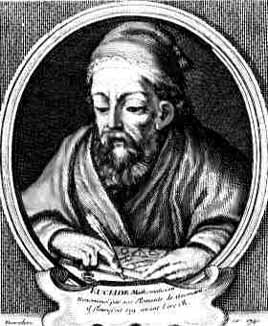
The Important Elements of Geometry
A Mathematical and Historical Webquest
By Stephanie Getz
|
|
The Important Elements of Geometry A Mathematical and Historical Webquest By Stephanie Getz
|
![]()
|
|
This webquest will take you back 2000 years to the times of Euclid to explore the origins of the geometry you are studying. This webquest will help you understand the significant impact Euclid's Elements has had on mathematics and history. In your quest you will be introduced to other geometric worlds much different from what you are accustomed. |
Back to top
![]()
|
|
Your task in this webquest will be to explore Book I of Euclid's Elements and the history of the Elements (both of Euclid's time and after) through the internet. The products of this webquest will include the following: |
||
|
|
|
|
|
|
|
|
|
|
![]()
|
|
You may work in groups of 2 or 3 on this project. The following are recommendations on how to get started on this webquest. Selecting the Propositions and Constructions |
|
|
|
|
Go the Euclid's Elements with Movable Figures on-line and explore Book I by reading the Definitions, Axioms, Common Notions and Propositions. Play with the movable figures. Explore other sites containing the Elements. See Resources below Go to the Virtual Straight Edge and Compass and try some of the constructions found in Book I. Choose the 5 Propositions and 2 Constructions you would like to use in your project. Bring them to me for approval. (I want to distribute all the Propositions throughout the class). |
|
|
Proofs of Propositions and Constructions |
|
|
|
|
Everyone in the group must be able to prove all 5 Propositions and perform and prove the 2 constructions your group chooses. I will randomly select students from each group to present these. |
|
|
|
You may use previous Propositions in your proof, but no Proposition following the one you are using may be used in your proof. Be able to tell me the reason for this. Feel free to use Sketchpad or any other geometry programs in this task. |
|
|
Essay |
|
|
|
|
Search sites about the History of Math using keywords such as Euclid, Euclidean geometry, Non-Euclidean geometry, Greek Mathematics, Parallel Postulate, Bolyai, Lobachevsky When writing your essay, you may organize the essay as you want. Try to include graphics to help explain ideas you are discussing. |
![]()
Virtual Straight Edge and Compass
Euclid's Elements with Movable Figures
Byrne's Editions of Euclid's Elements
Introduction to the Works of Euclid
![]()
|
|
Points |
Grading Criteria Points will be awarded for the following: |
||
|
|
Propositions 50 pts |
i) completeness, correctness, and clarity of the proofs, ii) appropriate diagrams and labeling, iii) quality of student presentations |
||
|
|
(Written: 30, Presentation: 20) |
|
||
|
|
Constructions 50 pts |
i) completeness, correctness, and clarity of the construction and proof, ii) appropriate diagrams and labeling, iii) quality of student presentations |
||
|
|
(Written: 30, Presentation: 20) |
|||
|
|
Essay 100 pts |
i) addressing all items as discussed in the Task section, ii) addressing appropriate items not included in the Task section, iii) appropriate and logical organization, iv) clarity, v) correct grammar, and vi) originality |
||
|
|
Total 200 pts |
|
||
![]()
Through this webquest you will discover why Euclid's Elements was different than any mathematics text before it and how over 2000 years later the Elements has stood the test of time to be the basis of what is presently taught in high school geometry.
![]()
Last Revised: 8/04/99